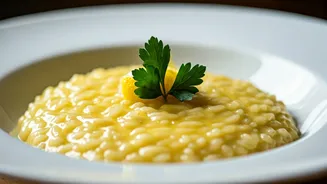Risotto: A Foundation
Risotto, a cornerstone of Italian cuisine, begins with Arborio rice, a short-grain variety. The starches in Arborio, when released slowly during cooking,
are what give risotto its signature creamy consistency. The foundational technique involves gently toasting the rice in a pan, often with a bit of butter or olive oil. This step helps to create a nutty flavor profile and prevents the rice from becoming overly starchy. Then, hot liquid, typically broth or water, is gradually added, a ladleful at a time, allowing it to be absorbed before the next addition. Constant stirring is crucial during this process; this ensures even cooking and the release of starch. This slow, patient process is what distinguishes risotto from other rice dishes.
Essential Ingredients Unveiled
To create an exceptional Risotto al Limone, gather the essential ingredients. High-quality Arborio rice is a must. Fresh lemons are the stars here, providing both juice and zest for a bright, citrusy flavor. The stock or water used should be warm before adding to the rice. Butter or olive oil, depending on your preferences, enriches the flavor and contributes to the creamy texture. Parmesan cheese, freshly grated, adds a salty and savory finish. Additional flavor components such as onion or shallots are often sautéed at the beginning to create a flavor base, enhancing the complexity of the dish. A pinch of salt and pepper to season the dish properly is also important.
Step-by-Step Preparation
Begin by sautéing finely chopped onions or shallots in butter or olive oil. Add the Arborio rice and toast it for a few minutes, stirring continuously. This step helps to bring out the nutty flavor of the rice. Gradually add warm liquid (broth or water), a ladleful at a time, stirring constantly until each addition is absorbed before adding the next. This slow cooking allows the rice to release its starch, creating a creamy texture. Near the end of the cooking time, add the lemon zest and juice. Once the rice is al dente (tender with a slight bite), remove it from the heat. Stir in the butter and grated Parmesan cheese. This process, known as mantecatura, enriches the risotto and gives it its final creamy texture. Season with salt and pepper to taste. Serve immediately, garnished with a sprinkle of extra Parmesan cheese and lemon zest.
Variations and Twists
While the core of Risotto al Limone remains constant, feel free to experiment with variations. A touch of white wine added during the initial stages of cooking provides a layer of complexity. For a bolder flavor, consider adding a knob of mascarpone cheese along with the Parmesan. Some cooks incorporate herbs like parsley or chives at the end for an added touch of freshness. Adding a bit of saffron can give it a beautiful color. For a richer, more decadent risotto, try using a vegetable stock instead of water. Another way to enhance the flavor is to add a small amount of lemon-infused olive oil just before serving. With some creativity, Risotto al Limone offers many possibilities for a delightful, flavorful dining experience.
Serving Suggestions
Risotto al Limone can be served as a delightful first course or a light main dish. It pairs exceptionally well with grilled fish or seafood, complementing the citrusy flavors. A simple green salad with a light vinaigrette provides a refreshing counterpoint. For a vegetarian option, consider serving it with roasted vegetables. The risotto also stands well on its own, garnished with a sprig of fresh herbs and a drizzle of olive oil. Offering a glass of crisp white wine can add to the whole dining experience. The dish is also perfect for a dinner party, as it is relatively easy to make while appearing to be a sophisticated dish.











